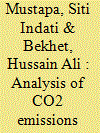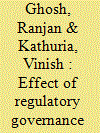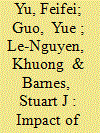|
|
|
Sort Order |
|
|
|
Items / Page
|
|
|
|
|
|
|
| Srl | Item |
| 1 |
ID:
150781


|
|
|
|
|
| Summary/Abstract |
The demand for transport services is expected to rise, causing the CO2 emissions level to increase as well. In Malaysia, the transportation sector accounts for 28% of total CO2 emissions, of which 85% comes from road transport. By 2020, Malaysia is targeting a reduction in CO2 emissions intensity by up to 40% and in this effort the role of road transport is paramount. This paper attempts to investigate effective policy options that can assist Malaysia in reducing the CO2 emissions level. An Optimisation model is developed to estimate the potential CO2 emissions mitigation strategies for road transport by minimising the CO2 emissions under the constraint of fuel cost and demand travel. Several mitigation strategies have been applied to analyse the effect of CO2 emissions reduction potential. The results demonstrate that removal of fuel price subsidies can result in reductions of up to 652 ktonnes of fuel consumption and CO2 emissions can be decreased by 6.55%, which would enable Malaysia to hit its target by 2020. CO2 emissions can be reduced significantly, up to 20%, by employing a combination of mitigation policies in Malaysia. This suggests that appropriate mitigation policies can assist the country in its quest to achieve the CO2 emissions reduction target.
|
|
|
|
|
|
|
|
|
|
|
|
|
|
|
|
| 2 |
ID:
150792


|
|
|
|
|
| Summary/Abstract |
A large number of studies have been conducted on the contribution of technological progress and structural change to the evolution of aggregate energy intensity in the industrial sector. However, no analyses have been done to examine theses changes in the non-energy intensive industry in France. We analyzed their importance in French industry with respect to their energy intensity, energy costs, value added, labour and the diffusion of production sites by using data at the 3-digit level with 236 sectors. Using a new decomposition method that gives no residual, this paper attempted to examine, over 10 years from 1996 to 2005, the changes that occurred in an area that has been neglected in energy analysis. We found that structural change had an overwhelming effect on the decline of aggregate energy intensity. Furthermore, we found that the higher the level of sector disaggregation, the more significant the changes that can be attributed to structural change, due to the homogeneity of this industrial group. The results of our study show that it is important to take into account the effects of structural change in “bottom-up” modelling exercises so as to improve the accuracy of energy demand forecasting for policy-makers and scientists.
|
|
|
|
|
|
|
|
|
|
|
|
|
|
|
|
| 3 |
ID:
150774


|
|
|
|
|
| Summary/Abstract |
Affordable energy supply and reductions in emissions of local air pollution and greenhouse gases are each important aspects of South Africa's goals. Many traditional solutions, however, work in contradiction to one another. This work investigates effects on estimated emissions and costs of mitigation strategies using the Greenhouse Gas and Air Pollution Interaction Synergies (GAINS) model to identify policies that satisfy multiple goals. Eight scenarios that describe air pollution control options and mixes of energy production technologies are implemented in GAINS, which quantifies country-wide air pollution and greenhouse emissions and costs of controls. Emissions and costs trajectories are compared to the business as usual case, which projects CO2 emissions to increase by 60% by 2050 compared to 2015. Results show that replacing all coal generation with renewables reduces CO2 emissions in 2050 by 8% compared to 2015, and that aggressive policy targeting the whole energy sector reduces CO2 emissions in 2050 by 40%. GAINS is used to show co-benefits and tradeoffs of each scenario, such as reductions in emissions control costs that accompany a switch to renewables. The approach provides supporting evidence for policies that exploit co-benefits and avoid contradictions by assessing multiple aspects of the energy sector within the integrated framework provided by the GAINS modeling platform.
|
|
|
|
|
|
|
|
|
|
|
|
|
|
|
|
| 4 |
ID:
150767


|
|
|
|
|
| Summary/Abstract |
The European power sector is transforming due to climate policies and an increased deployment of intermittent RES. The sector will require thermal power plants for the decades to come, but their business cases are (negatively) affected by this transformation. This study presents a novel tool to quantify the effect of policy, price and project-related uncertainties on power plant business cases. This tool can support policymakers in stimulating necessary investments in new thermal generation capacity. We find that these investments are currently unsound (power plants recoup on average –12% to 59% of their initial investment). Future climate policy, i.e. the CO2 price, has a very strong impact on business cases (affects the profitability by 5–40%-points). The impact of the deployment of wind power is average (2–8%-point difference between 10% and 21% wind penetration). Variations in annual wind power production barely affect the profitability (variation of ±1%-point). To stimulate new investments, policymakers should first decrease the uncertainty in business cases caused by policy. Durable climate policy is especially important. Also, policies to increase the profits of thermal power plants should be carefully considered and implemented. This combined approach will reduce the revenue gap that needs to be bridged by supportive policies.
|
|
|
|
|
|
|
|
|
|
|
|
|
|
|
|
| 5 |
ID:
150771


|
|
|
|
|
| Summary/Abstract |
This paper investigates the impact of institutional quality – typified as regulatory governance – on the performance of thermal power plants in India. The Indian power sector was reformed in the early 1990s. However, reforms are effective only as much as the regulators are committed in ensuring that they are implemented. We hypothesize that higher the quality of regulation in a federal Indian state, higher is the efficiency of electric generation utilities. A translog stochastic frontier model is estimated using index of state-level independent regulation as one of the determinants of inefficiency. The dataset comprises a panel of 77 coal-based thermal power plants during the reform period covering over 70% of installed electricity generation capacity. The mean technical efficiency of 76.7% indicates there is wide scope for efficiency improvement in the sector. Results are robust to various model specifications and show that state-level regulators have positively impacted plant performance. Technical efficiency is sensitive to both unbundling of state utilities, and regulatory experience. The policy implication is that further reforms which empower independent regulators will have far reaching impacts on power sector performance.
|
|
|
|
|
|
|
|
|
|
|
|
|
|
|
|
| 6 |
ID:
150788


|
|
|
|
|
| Summary/Abstract |
Power grid interconnection has gained attention in Northeast Asia (NEA) as a means to build an economically efficient power system and to effectively utilize renewable energy, such as wind and solar resources in the Gobi Desert and hydro resources in Eastern Russia.
|
|
|
|
|
|
|
|
|
|
|
|
|
|
|
|
| 7 |
ID:
150791


|
|
|
|
|
| Summary/Abstract |
China is very active in the research and development of CO2 capture and storage technologies (CCS). However, existing estimates for CO2 storage capacity are very uncertain. This uncertainty is due to limited geological knowledge, a lack of large-scale research on CO2 injection, and different assessment approaches and parameter settings. Hence storage scenarios represent a method that can be used by policy makers to demonstrate the range of possible storage capacity developments, to help interpret uncertain results and to identify the limitations of existing assessments. In this paper, three storage scenarios are developed for China by evaluating China-wide studies supplemented with more detailed site- and basin-specific assessments. It is estimated that the greatest storage potential can be found in deep saline aquifers. Oil and gas fields may also be used. Coal seams are only included in the highest storage scenario. In total, the scenarios presented demonstrate that China has an effective storage capacity of between 65 and 1551 Gt of CO2. Furthermore, the authors emphasise a need for action to harmonise storage capacity assessment approaches due to the uncertainties involved in the capacity assessments analysed in this study.
|
|
|
|
|
|
|
|
|
|
|
|
|
|
|
|
| 8 |
ID:
150776


|
|
|
|
|
| Summary/Abstract |
This paper investigates the role of emissions control in welfare maximization under fat-tailed risk about climate change. We provide a classification of fat tails and discuss the effect of fat-tailed risk on climate policy. One of the main findings is that emissions control may prevent the “strong” tail-effect from arising, at least under some conditions such as bounded temperature increases, low risk aversion, low damage costs, and bounded utility function. More specifically, the fat-tailed risk with respect to a climate parameter does not necessarily lead to an unbounded carbon tax. In this case, the basic principle of cost-benefit analysis maintains its applicability.
|
|
|
|
|
|
|
|
|
|
|
|
|
|
|
|
| 9 |
ID:
150770


|
|
|
|
|
| Summary/Abstract |
There has been a concentrated effort by European countries to increase the share of electric vehicles (EVs) and an important factor in the rollout of the associated infrastructure is an understanding of the charging behaviours of existing EV users in terms of location of charging, the quantity of energy they require, charge duration, and their preferred mode of charging. Data were available on the usage of charging infrastructure for the entire island of Ireland since the rollout of infrastructure began. This study provides an extensive analysis of this charge event data for public charging infrastructure, including data from fast charging infrastructure, and additionally a limited quantity of household data. For the household data available, it was found that EV users prefer to carry out the majority of their charging at home in the evening during the period of highest demand on the electrical grid indicating that incentivisation may be required to shift charging away from this peak grid demand period. Car park locations were the most popular location for public charging amongst EV users, and fast chargers recorded the highest usage frequencies, indicating that public fast charging infrastructure is most likely to become commercially viable in the short- to medium-term.
|
|
|
|
|
|
|
|
|
|
|
|
|
|
|
|
| 10 |
ID:
150779


|
|
|
|
|
| Summary/Abstract |
In spite of the extensive literature on greenhouse gas emission inequalities at the world-wide level, most of the evidence so far has been based on country-level data. However, the within-country dimension matters for both the implementation and the policy formation of climate policies. As a preliminary step towards a better understanding of within-country inequalities, this paper measures their extent for the two major greenhouse gases, CO2 and CH4, over the 1970–2008 period. Using Theil-index decompositions, we show that within-country inequalities account for the bulk of global inequality, and tend to increase over the sample period, in contrast with diminishing between-country inequalities. Including differences across sectors reveals that between-sector inequalities matter more than between-country inequalities, and between-sector inequalities become the dominant source of global inequality at the end of the sample period in the CO2 case. Finally, estimated social tensions arising from the disconnection between emissions and future damages turn out to be increasing as soon as within-country disparities are taken into account. These orders of magnitude should be kept in mind while discussing the efficiency and fairness of alternative paths in combating global warming.
|
|
|
|
|
|
|
|
|
|
|
|
|
|
|
|
| 11 |
ID:
150784


|
|
|
|
|
| Summary/Abstract |
In June 2015, China announced its post-2020 reduction targets, its central element being the intention to peak CO2 emissions by 2030 or earlier. China has implemented several policies to reduce its greenhouse gas (GHG) emissions. This study provides emission projections for China up to 2030 given current policies and a selected set of enhanced policies, and compares the results with projected CO2 emission trajectories that are consistent with the announced target for 2030. The projections are based on existing scenarios and energy system and land use model calculations. We project that the 2030 CO2 emission level consistent with a peak in CO2 emissions by 2030 ranges from 11.3 to 11.8 GtCO2. The corresponding total GHG emission level ranges from 13.5 to 14.0 GtCO2e in 2030. Current policies are likely not to be sufficient to achieve the 2030 targets, as our projected total GHG emission level under current policies ranges from 14.7 to 15.4 GtCO2e by 2030. However, an illustrative set of enhancement policy measures, all of which are related to national priorities, leads to projected GHG emission levels from 13.1 to 13.7 GtCO2e by 2030 – and thus below the levels necessary for peaking CO2 emissions before 2030.
|
|
|
|
|
|
|
|
|
|
|
|
|
|
|
|
| 12 |
ID:
150785


|
|
|
|
|
| Summary/Abstract |
China is planning to introduce emission trading scheme (ETS) to decrease CO2 emission. As low carbon energy (LCE) will play a pivotal role in reducing CO2 emissions, our paper is to assess the extent and the conditions under which a carbon ETS can deliver LCE investment in China. We chose wind technology as a case study and a real-option based model was built to explore the impact of a number of variables and design features on investment decisions, e.g. carbon and electricity price, carbon market risk, carbon price floor and ceiling and on-grid ratio. We compute critical values of these variables and features and explore trade-offs among them. According to our work, a carbon ETS has a significant effect on wind power plant investment although it cannot support investment in wind power on its own. Carbon price stabilization mechanisms such as carbon price floor can significantly improve the effect of carbon ETS but the critical floor to support investment is still much higher than the carbon price in China pilot ETSs. Our results show that other policy measures will be needed to promote low-carbon energy development in China.
|
|
|
|
|
|
|
|
|
|
|
|
|
|
|
|
| 13 |
ID:
150793


|
|
|
|
|
| Summary/Abstract |
Enhancing energy technology innovation performance, which is widely measured by energy technology patents through energy technology research and development (R&D) activities, is a fundamental way to implement energy conservation and emission abatement. This study analyzes the effects of R&D investment activities, economic growth, and energy price on energy technology patents in 30 provinces of China over the period 1999–2013. Several unit root tests indicate that all the above variables are generated by panel unit root processes, and a panel cointegration model is confirmed among the variables. In order to ensure the consistency of the estimators, the Fully-Modified OLS (FMOLS) method is adopted, and the results indicate that R&D investment activities and economic growth have positive effects on energy technology patents while energy price has a negative effect. However, the panel error correction models indicate that the cointegration relationship helps to promote economic growth, but it reduces R&D investment and energy price in the short term. Therefore, market-oriented measures including financial support and technical transformation policies for the development of low-carbon energy technologies, an effective energy price mechanism, especially the targeted fossil-fuel subsidies and their die away mode are vital in promoting China's energy technology innovation.
|
|
|
|
|
|
|
|
|
|
|
|
|
|
|
|
| 14 |
ID:
150787


|
|
|
|
|
| Summary/Abstract |
A great deal has been written about the Energy Policy Act of 2005 exempting oil and gas operations using hydraulic fracturing from the purview of certain federal environmental laws. Far less attention has been paid to George W. Bush's Executive Order 13211 (EO 13211), entitled “Actions Concerning Regulations that Significantly Affect Energy Supply, Distribution or Use.” The Executive Order requires federal agencies to evaluate the impact of federal regulations on “supply, distribution and use of energy.”
|
|
|
|
|
|
|
|
|
|
|
|
|
|
|
|
| 15 |
ID:
150766


|
|
|
|
|
| Summary/Abstract |
In this research, we aim to understand the influence of government subsidies on enterprises’ research and development (R&D) investment behavior, particularly in China’s renewable energy sector. We are also interested in examining how the attributes of enterprise ownership act as a moderating variable for the relationship between government subsidies and R&D investment behavior. Three classical panel data analysis models including the pooled ordinary least squares (OLS) model, the fixed effect model and the random effect model are employed. We find that government subsidies have a significant crowding out influence on enterprises’ R&D investment behavior and that the influence is further moderated by the attributes of enterprise ownership. Moreover, a panel threshold regression model is used to demonstrate how the influence of government subsidies on enterprises’ R&D investment behavior will change when government subsidies increase. Two thresholds, 0.6% and 10.1%, are identified. We recommend that relevant government departments should motivate enterprise R&D investment behavioral intention by increasing subsidies within a certain range. Different attributes of enterprise ownership should also be considered as part of policy reform and re-structuring relating to government subsidies.
|
|
|
|
|
|
|
|
|
|
|
|
|
|
|
|
| 16 |
ID:
150777


|
|
|
|
|
| Summary/Abstract |
Decision making in Iran's energy and environment-related issues has always been tied to complexities. Discussing these complexities and the necessity to deal with them, this paper strives to help the country with a tool by introducing Richest Alternatives for Implementation to Supply Energy (RAISE), a mixed integer linear programming model developed by the means of GNUMathprog mathematical programming language. The paper fully elaborates authors' desired modeling mentality and formulations on which RAISE is programmed to work and verifies its structure by running a widely known sample case named “UTOPIA” and comparing the results with other works including OSeMOSYS and Temoa. The model applies RAISE model to Iranian energy sector to elicit optimal policy without and with a CO2 emission cap. The results suggest promotion of energy efficiency through investment on combined cycle power plants as the key to optimal policy in power generation sector. Regarding oil refining sector, investment on condensate refineries and advanced refineries equipped with Residual Fluid Catalytic Cracking (RFCC) units are suggested. Results also undermine the prevailing supposition that climate change mitigation deteriorates economic efficiency of energy system and suggest that there is a strong synergy between them. In the case of imposing a CO2 cap that aims at maintaining CO2 emissions from electricity production activities at 2012 levels, a shift to renewable energies occurs.
|
|
|
|
|
|
|
|
|
|
|
|
|
|
|
|
| 17 |
ID:
150786


|
|
|
|
|
| Summary/Abstract |
Wind energy is an emerging source for renewable energy. This article presents an application of the economic input–output life cycle assessment (EIO-LCA) to estimate the greenhouse gas (GHG) emissions through the life cycle of wind energy farms in a state. The EIO-LCA incorporates manufacturing, installation, operation and maintenance, and decommissioning of the wind turbine over its life cycle period. In doing so, the study demonstrates that O&M and decommissioning of infrastructure with a longer life period can be considered to assess the total environmental impacts. The life cycle costs of wind turbine installation in Indiana is used in this study. The uncertainty in wind energy production, and hence the variability in GHG emission intensities in metric tons per gigawatt hour (GWh), is demonstrated by using the Monte Carlo simulation. The research finds that wind energy production is not entirely GHG emission-free if all the costs and life cycle stages are considered. Emission estimates have uncertainty, and O&M and decommissioning can add up to 200 metric tons of GHG emissions in CO2e per wind turbine life cycle. The regional EIO-LCA can be a helpful tool to determine strategies for state compliance to initiatives, such as the Clean Power Plan.
|
|
|
|
|
|
|
|
|
|
|
|
|
|
|
|
| 18 |
ID:
150773


|
|
|
|
|
| Summary/Abstract |
Installations of rooftop solar photovoltaic (PV) technology in the United States have increased dramatically in recent years, in large part because of state and federal subsidies. In the future, such subsidies may be reduced or eliminated. From the homeowner's perspective, solar PV is competitive when it can produce electricity at a cost equivalent to the retail electricity rate, a condition sometimes referred to as “socket parity”. In assessing the economic viability of residential solar PV, most existing literature considers only a few locations and fails to consider the differences in PV system cost and electricity prices that exist across the U.S. We combined insolation data from more than 1000 locations, installation costs by region, and county-level utility rates to provide a more complete economic assessment of rooftop solar PV across the U.S. We calculated the break-even electricity prices and evaluated the reductions in installed costs needed to reach socket parity. Among the scenarios considered, we estimate that only Hawaii has achieved socket parity without the use of subsidies. With subsidies, six states reach socket parity, yet widespread parity is still not achieved. We find that high installation costs and financing rates are two of the largest barriers to socket parity.
|
|
|
|
|
|
|
|
|
|
|
|
|
|
|
|
| 19 |
ID:
150783


|
|
|
|
|
| Summary/Abstract |
The Korean governmental support for supply security of oil and gas via overseas exploration and production (E&P) projects are publicly criticized because of some poor projects lacking of economic feasibility, even though it should be expanded from a long-term perspective. Applying the contingent valuation, this study investigates the Korean public's preferences for governmental support for overseas oil and gas E&P projects. The result shows that the governmental support for overseas E&P projects rather decreases public utility. The primary reason behind this utility decrease is that some respondents protested to bid because of their resistance toward tax increase without guaranteeing the efficient government support. This result implies that simple tax increases for expansion of the governmental support may bring about public's strong opposition. In order to overcome this public opposition, this study suggests that it is necessary to arouse public understanding of the necessity of overseas oil and gas E&P projects.
|
|
|
|
|
|
|
|
|
|
|
|
|
|
|
|
| 20 |
ID:
150772


|
|
|
|
|
| Summary/Abstract |
Feed-in tariffs and Renewable Portfolio Standards (RPS) are among the most prominent policies to address anthropogenic influence on climate change. Implementation of RPS favorably affects renewable energy supply and rural development while reducing the land available for meeting demand for food and feed resulting from global population growth. Even in the vast Great Plains of the United States, land requirements are primary considerations between increasing renewable energy capacity and food and feed production.
|
|
|
|
|
|
|
|
|
|
|
|
|
|
|
|
|
|
|
|
|